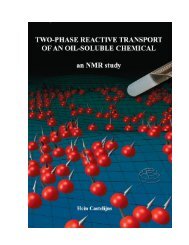P - Technische Universiteit Eindhoven
P - Technische Universiteit Eindhoven
P - Technische Universiteit Eindhoven
You also want an ePaper? Increase the reach of your titles
YUMPU automatically turns print PDFs into web optimized ePapers that Google loves.
3. Crystallization under wetting/non-wetting conditions 33<br />
of a non-wetting condition the contact lines between fluid and solid are free to move, and<br />
as a result the droplet will shrink almost uniformly during drying. In this case it is found<br />
that the concentration remains homogeneous throughout the droplet [64, 65].<br />
In the case of a wetting surface the contact lines are pinned. As a result the contact<br />
angle will change during drying and inhomogeneous drying will occur, since the evaporation<br />
per unit fluid volume will be largest along the rim of the droplet. Consequently,<br />
there will be salt transport by advection towards the rim. This is also known as the coffee<br />
stain effect [65–67], where after complete evaporation of a droplet the edge of the stain<br />
has a more pronounced color than the inner part.<br />
In general, the transport of ions in a fluid can be described by a diffusion-advection<br />
equation:<br />
∂c<br />
∂t = D∇2 c − ⃗ U · ∇c , (3.1)<br />
where c is the concentration in molals [M = mole/kg], D [m 2 s −1 ] the ion diffusion coefficient,<br />
and U the water velocity [m s −1 ]. The competition between advection and diffusion<br />
can be defined in terms of the Peclet number [68]:<br />
P e ≡ |⃗ U|L<br />
D , (3.2)<br />
where L [m] is the length scale of interest, e.g., the diameter of the droplet.<br />
In the case of wetting conditions we expect that P e > 1 and hence concentration<br />
gradients are present which could influence the crystallization dynamics [65]. On the<br />
other hand, for non-wetting surfaces we expect P e < 1 and, consequently, a homogeneous<br />
crystallization behavior throughout the droplet.<br />
3.3 Experimental setup<br />
We have used a Nuclear Magnetic Resonance (NMR) setup operating at a field of 0.78 T<br />
in this study to measure the concentration in the droplet non-destructively while drying.<br />
An extensive description of this setup can be found in [29, 40]. In order to create either<br />
wetting or non-wetting conditions during drying of a droplet, two types of sample holders<br />
were manufactured from transparent quartz-glass and Polymethyl Methacrylate (PMMA),<br />
respectively. Each type of sample holder has a height of 15 mm, a diameter of 20 mm,<br />
and a flat bottom.<br />
A schematic representation of the experimental setup is given in figure 3.2. The<br />
NMR setup is equipped with a Faraday shield to suppress the effect of changes of the<br />
dielectric properties of the sample [29]. In addition, the quality factor of the LC circuit<br />
containing the sample is chosen rather low (Q ≈ 40), to suppress the effects of the<br />
(electrically conducting) sodium sulfate solution. The tuned circuit of the setup can be<br />
toggled between 33 MHz for 1 H and 8.9 MHz for 23 Na, giving the possibility to quasisimultaneously<br />
measure the Na and H content, and thereby the concentration.<br />
At the echo times used in the experiments (T E = 750 µs for Na and 650 µs for H),<br />
only the Na and H nuclei in the solution are measured and no signal is obtained from these<br />
nuclei incorporated in sodium sulfate crystals. The magnetic field gradient was chosen
















